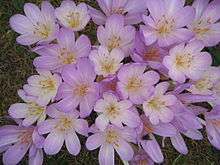Colchicum × byzantinum
Colchicum × byzantinum, the Byzantine meadow saffron, is a species of flowering plant in the family Colchicaceae with a long history of cultivation, and no certain place of origin. It is thought to be a hybrid of other species.[1]
| Colchicum × byzantinum | |
|---|---|
 | |
| Scientific classification | |
| Kingdom: | Plantae |
| Clade: | Tracheophytes |
| Clade: | Angiosperms |
| Clade: | Monocots |
| Order: | Liliales |
| Family: | Colchicaceae |
| Genus: | Colchicum |
| Species: | C. × byzantinum |
| Binomial name | |
| Colchicum × byzantinum Ker Gawl. | |
It shares many traits with Colchicum cilicicum. The flowers, which appear in autumn, have no scent and are light pink with a prominent central white stripe. Each tepal has a purple tip, even white selections. This plant is very reliable in gardens,[2] and has gained the Royal Horticultural Society’s Award of Garden Merit[3] (confirmed 2017).[4]
Colchicums resemble crocuses. However, they belong to a different family, and unlike crocuses are toxic if eaten.
The specific epithet byzantinum means "from Byzantium" (now Istanbul).[5]
See also
References
- "Colchicum × byzantinum Ker Gawl". Retrieved 8 April 2020.
- Autumn Bulbs by Roy Leeds (B.T. Batsford Ltd) 2006 ISBN 0-7134-8962-6
- "RHS Plantfinder - Colchicum byzantinum". Retrieved 12 January 2018.
- "AGM Plants - Ornamental" (PDF). Royal Horticultural Society. July 2017. p. 22. Retrieved 24 January 2018.
- Gledhill, David (2008). "The Names of Plants". Cambridge University Press. ISBN 9780521866453 (hardback), ISBN 9780521685535 (paperback). pp 82, 114